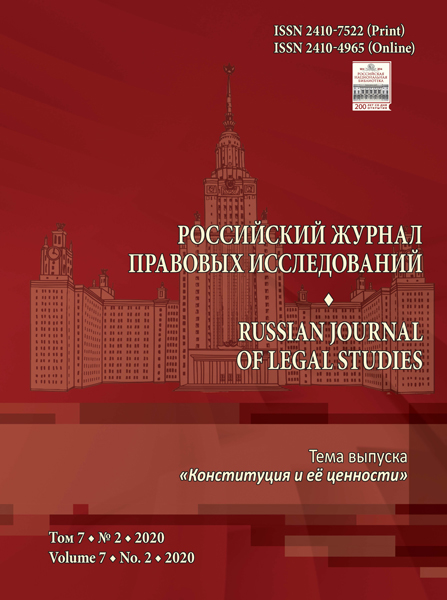Клаузула о выдаче в многосторонних международных договорах: международно-правовые аспекты
- Авторы: Кантур Р.А.1
-
Учреждения:
- Министерство иностранных дел Российской Федерации
- Выпуск: Том 7, № 2 (2020)
- Страницы: 78-83
- Раздел: Международно-правовые науки
- Статья получена: 12.05.2020
- Статья одобрена: 21.09.2020
- Статья опубликована: 02.11.2020
- URL: https://journals.eco-vector.com/2410-7522/article/view/34051
- DOI: https://doi.org/10.17816/RJLS34051
- ID: 34051
Цитировать
Полный текст
Аннотация
Предметом настоящей работы является комплекс международно-правовых норм, регулирующих вопросы выдачи в существующих многосторонних договорах в сфере международного уголовного права. В ходе исследования были использованы как общенаучные (анализ и синтез), так и частнонаучные (сравнительно-правовой, юридико-статистический, юридико-лингвистический) методы. Впервые проведен всесторонний анализ правового содержания клаузулы о выдаче в многосторонних международных договорах. Проведена правовая оценка данного механизма. Произведено сопоставление формулировок клаузулы в аутентичных текстах (русскоязычных и англоязычных) международных договоров в сфере международного уголовного права. Отмечается, что клаузула имеет непрямое действие и нуждается в имплементации государствами-участниками многостороннего международного договора, наряду с закрепленными в нем материально-правовыми нормами. В определенных обстоятельствах клаузула о выдаче позволяет рассматривать договор, в котором она содержится, в качестве особого субститута специального договора о выдаче, однако ее наличие не презюмирует включенность криминализуемых деяний международным договором, частью которого является, в существующие на момент выражения государством-участником своего согласия на обязательность двусторонние международные договоры. Несмотря на ряд достоинств включения клаузулы в тексты международных договоров в сфере международного уголовного права (в частности, отсутствие необходимости заключать отдельный договор о выдаче; способствование реализации материально-правовых норм договора; возможность обращения в международные судебные органы в случае возникновения разногласий по поводу применения или толкования норм международного договора), очевиден и ряд недостатков такого механизма, главным образом связанных с трудностями при имплементации договорно-правовых норм соответствующего договора и тем, что действие клаузулы покрывает только некоторые составы противоправных деяний.
Полный текст
Об авторах
Руслан Алексеевич Кантур
Министерство иностранных дел Российской Федерации
Автор, ответственный за переписку.
Email: ru.a.kantur@gmail.com
юрист отдела по борьбе с транснациональной организованной преступностью Департамента по вопросам новых вызовов и угроз
РоссияСписок литературы
- Мартенс Ф.Ф. Современное международное право цивилизованных народов: В 2-х т. Т. 2. М.: Зерцало, 2008. 251 с.
- Наумов А.В., Кибальник А.Г., Орлов В.Н., Волосюк П.В. Международное уголовное право / Под ред. А.В. Наумова и А.Г. Кибальника. М.: Юрайт, 2015. 510 с.
- Bantekas I., Nash S. International criminal law. London, Routledge, 2009. 640 p.
- Boczek B.A. International law: a dictionary. Lanham, MD.: Scarecrow Press, 2005. 477 p.
- Butler G.G., Maccoby S. The Development of international law. New York: The Lawbook Exchange, Ltd., 1928. 566 p.
- Darwall S. Honour, history, and relationship: essays in second-Personal Ethics II. Oxford: Oxford University Press, 2013. 285 p.
- Lauterpacht H. International law: general works, Vol. 1. Cambridge: Cambridge University Press, 1970. 562 p.
- Hawley J.G. The law and practice between the United States and those foreign countries with which It has treaties of extradition. Chicago: Callaghan and Company, 1893. 249 p.
- Phillimore R. Commentaries upon international law, Vol. 1. London: Butterworths, 1879. 3637 p.
- Pufendorf S. von. Le droit de la nature et des Gens. Amsterdam: Chez la veuve de Pierre de Coup, 1734. 716 p.
- Westlake J. International law. Part 1. Cambridge: Cambridge University Press, 1910. 715 p.
- Печегин Д.А. Состязательная и розыскная модели судопроизводства в Международном уголовном суде. М., 2017. 192 с.
Дополнительные файлы








